 [an error occurred while processing this directive]
[an error occurred while processing this directive]
 [an error occurred while processing this directive]
[an error occurred while processing this directive]

The PP&L Siting Problem
Perhaps this will come through even more convincingly with one
more case study. This is an actual applications demonstration
developed at NASA Goddard during the early 1980s when its Eastern
Regional Remote Sensing Applications Center (ERRSAC) was still
operating. The "client" was the Pennsylvania Power and Light (PP&L)
Company, a public electric utility whose service areas include
parts of central and eastern PA. One of these is the state capital
district at Harrisburg on the Susquehanna River that had been
receiving much of its power from the infamous Three Mile Island,
site of a nuclear power plant accident on March 28, 1979. This
experience forced PP&L to have special concerns regarding any of its
future sitings, both for its own power facilities and for its large
customers.
By the late '70s, PP&L had developed a computerized GIS primarily
for use in land use analysis, environmental impact analysis, energy
facility siting, and other technical assistance. Its multivariate
data base consisted of 43 data elements distributed in ten general
categories, the two largest being terrain units and land use.
The standard grid cell size in this data base is 9.2 hectares
(22.9 acres). The question prompting PP&L to approach ERRSAC in setting up a cooperative study: Can Landsat provide helpful input in keeping the GIS outputs up-to-date?
From these files, ERRSAC investigators used an ESRI
software package to generate a 12 class map of the Harrisburg
service area:
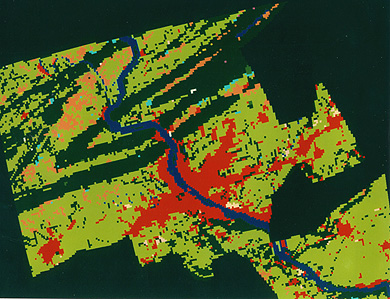
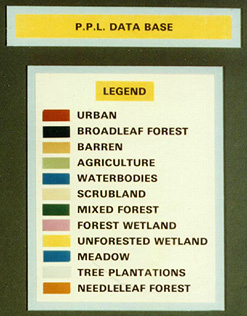
The proof-of-concept task presented by PP&L for a Goddard-directed GIS analysis
was to select the optimal site(s) for a heavy industrial complex.
Two primary limitations were imposed: 1) the site must be within
5 km (3 miles) from a major source of water (the Susquehanna River
met this condition), and 2) areas in the immediate Harrisburg
district are excluded.
The first step in the analysis was to generate a series of data
element maps from the PP&L data base. Six of the 23 so produced
are shown here:
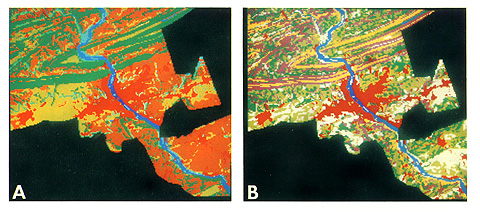
- A. Landforms: Urban = Red; Water = Dark Blue; Dissected Plateau = Brown;
Steep Slope = Dark Green; Valley Bottom = Greenish-yellow; Depression
= White; Floodplain = Aqua
- B. Slope: 0 - 3% = White; 3 - 8% = Light Green; 8 - 15% = Dark
Green; 15 - 25% = Purple; > 25% = Yellow; Urban = Red; Water =
Dark Blue
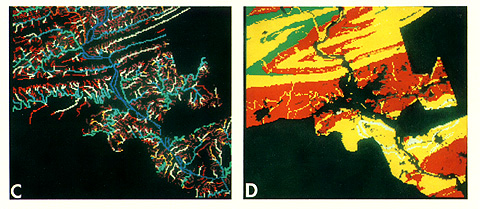
- C. Stream Order: 1st = Dark Blue; 2nd = Orange; 3rd = Aqua; 4th
= Light Blue; 5th = Yellow; 6th = White; 7th = Purple; 8th = Red
- D. Soil Permeability: Very High = Dark Green; High = Red; Good
= Yellow; Moderate = Orange; Poor = White
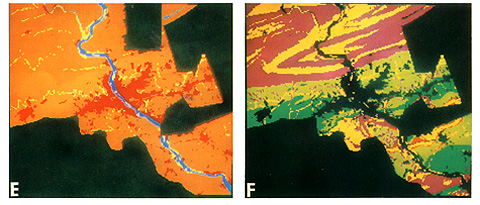
- E. Flood Prone Areas: Urban = Red; Water = Dark Blue; Flood Prone
= Yellow; Not Flood Prone = Orange
- F. Agricultural Potential: No Limit = Dark Green; Few Limits =
Light Green; Moderate Limits = Yellow; Severe Limits = Brown;
Extreme Limits = Purple
These, and other, maps are helpful to the GIS interpreter and
the planners in visualizing the distribution of variations within
a given attribute. In the analysis the different categories
within a theme are stored and manipulated by ordinal rankings
in a numeric code.

[an error occurred while processing this directive]

[an error occurred while processing this directive]

Code 935, Goddard Space Flight Center, NASA
Written by: Nicholas M. Short, Sr. email: nmshort@epix.net
and
Jon Robinson email: Jon.W.Robinson.1@gsfc.nasa.gov
Webmaster: Bill Dickinson Jr. email: rstwebmaster@gsti.com
Web Production: Christiane Robinson, Terri Ho and Nannette Fekete
Updated: 1999.03.15.